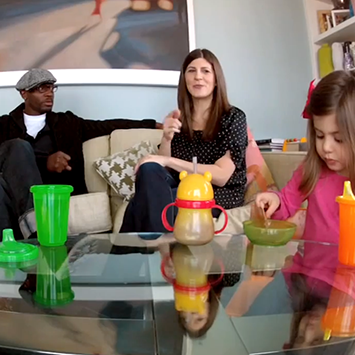Mazzy has been exhibiting less than stellar behavior lately. (Do I have to remind you about the “Toddler Fight Club” video from last week?) Things escalate from 0-60 faster than I can blink let alone run into the kitchen and pour a cup of juice or fish a pacifier out of the diaper bag or fast forward an episode of Sesame Street straight to (I’m doing it! I’m doing it!) Elmo’s World.
Also, I left a playground the other day because Mazzy couldn’t handle the line for the swings. (But I blame that more on the dumbass who created a playground with only TWO SWINGS. Do people get fired at playground-planning companies? BECAUSE THEY SHOULD.)
Like most parents, Mike and I have attributed this lack of self-control as a natural part of the toddler years. But this past weekend we had a brief moment where Mazzy got upset, lied face down on the floor and started beating her fists and kicking her feet like a cartoon drawing of your typical temper tantrum.
OH NO.
That was the moment I decided to seek some professional advice. Because if there is anything I could be doing to nip this behavior in the bud, I want to know about it. And you probably would too, right?
Thankfully I’ve got Dr. B at my disposal to give us all a lesson in teaching patience and self-control.
———————–
Young children live in the moment. They lack the ability to consider the consequences of their actions or recall set limits in time to stop themselves. Plus they do not yet understand the difference between good and bad behavior. Patience is also challenging for young children because they want things “Now!” and do not have the language or experience to understand why or when things they want will become available.
That being said, it has been found that a child’s ability to control their impulses and delay gratification is highly predictive of future academic success because without these skills children are unable to listen, attend to instructions, and learn.
Patience and self-control will naturally improve with typical development because as children learn language, it provides them with an internal dialogue to regulate their behavior. Plus, with age, long-term memory increases which helps children remember rules and limits set previously.
There are also a variety of methods you can use to aid your child in developing these important skills.
6 Ways to Teach a Toddler Patience and Self-Control
Play Games that Teach Self-Control: Children learn self-control by learning how to stop and control their bodies. There are many games that you can play that can help children learn to control their bodies, listen and follow directions. Play games using the words “stop and go,” “fast and slow,” “loud and soft” or “whisper and shout.”
Familiar games include “Duck, Duck, Goose”, “Red Light, Green Light”, “Follow the Leader”, “Hot Potato” and “Simon Says”. You can use these examples to create your own simpler versions for younger children. For example, you can make a game out of walking in the street where you say “go, go, go” on the sidewalk and then “stop” on every corner.
Music and Movement: There are many children’s songs that require children to pair words with actions which provide opportunities for children to practice self-control and good listening skills. “Freeze Dance” is a great game to start with because it is easy for children with limited language to understand. Many children’s CDs have songs that encourage children to perform different actions (e.g., Head, Shoulders, Knees and Toes) as well as songs with different tempos that teach children to control their bodies by moving fast or slow.
Teach Waiting: Increase your child’s ability to wait by slowly increasing the time between the request and the delivery of the desired item. You can use the word “wait” consistently to help your child begin to understand that this word means that the item or action is coming. For instance, if your child is requesting an item, you can say, “Sure, I’ll get it for you. Wait a minute mommy is coming.” Then slowly add wait time by making comments about preparing the food item or trying to find the item, while reassuring your child that the item is on its way. Also you can use other natural opportunities to teach the word “waiting” while waiting for the elevator to open, waiting in line, or waiting for a turn on the swing or slide.
Make Waiting Concrete: Use visual timers or kitchen timers to help your child begin to understand the concept of time and to teach them to wait for certain things that are not yet available (e.g., to show and explain that dinner will not be ready for 10 minutes). Timers are also helpful to teach siblings to take turns with things that cannot be shared such as the computer or television. Explain that when they hear or see the timer go off, they will get the activity or item they want.
Give Choices that Encourage Delayed Gratification: Try to bargain with your child by making comments like, “you can have one cookie now, or you can have two cookies if you wait until after dinner.” These types of choices will encourage your child to control their impulses and desire for instant gratification and instead wait to get a bigger reward at a later time – a very important lesson they will benefit from later in life.
Be a Role Model for Self-Control: Model for your child how to stay calm in frustrating situations. Verbalize your feelings and how you are coping with them in front of your child. Do not overreact to situations by yelling or losing control when you are angry because then your child will learn that this is an acceptable way to express their feelings. Instead, if something is upsetting you or you feel angry, make comments like, “I’m very mad right now. I’m going to take a deep breath and calm down. It’s okay. I can handle this.” This type of language will help your child learn that it is okay to have strong feelings but that there are appropriate ways of coping with them.
Finally, the best approach to helping children develop patience and self-control is providing them with a predictable environment where they know what to expect and what is expected of them. Providing children with a consistent routine, continuously teaching and reviewing rules and expectations, using consistent language to teach new skills, setting consistent limits and praising good behavior will improve your child’s capacity to develop a degree of self-control and patience that will enable them to manage their own behavior in the future.
Dr. B has a PHD in early childhood development. If you have a question for her, please email me at myshort@mommyshorts.com.


























I think I need to work on the last tip first. I have little patience usually which is probably why my kids don’t either.
Haha this is a great comment. I hear ya!
I was just thinking the same. I have a short fuse sometimes. So I am partially to blame for his toddler tantrums.
I really like that games can help. We love to play games together.
Thanks Dr. B!
This is a really good post. I have noticed that my kids have gotten better as self control and waiting with age but with triplets in the house, taking turns is just something that has to happen.
Or you can just get her her own iPhone.
Ilana, your description of how things escalate from 0-60 – OMG, me too.
Dr B, such great ideas! I’m going to have to try them ASAP. Thank you!
Rebecca doesn’t have too many words yet, so I get a lot of the “throwing herself on the floor and screaming for seemingly no reason”.
I’m trying to do something my sister taught me — to try not dump things on her with no warning. Rebecca tends to get really mad when she’s outside and I tell her she has to go inside. She usually ignores me, I try to take her hand and lead her inside, she throws herself on the ground crying, I have to pick her up, and carry her inside yelling a lot. I’m trying to let her know “In 2 minutes, we’re going to go inside” “1 more minute…”
I know she doesn’t “get it” in terms of the measure of time, but at least she knows what “inside” means, and maybe that me saying it over and over is at least reducing the shock factor..
Yes!! My toddler speaks only a few words so I am not sure he gets what I’m saying most of the time. He is a little fire cracker if I tell him no or no more or wait..the word “no” is engrained in his mind. I want to try the freeze dance game. Or the timer…because right now, words are almost useless.
That’s perhaps the most important one in the bunch, isn’t it?
Translation: We are all screwed.
I can’t even imagine. I’m sure it’s much easier for Mazzy to wrestle the iPad away from her dad than it would be from *shudder* another Mazzy.
She already takes ownership of our iPad. The least we could do is give her access to the full family of Apple products. I don’t let her touch my iPhone ever since the whole “slobbering on it to death” incident:
https://www.mommyshorts.com/2011/04/baby-kills-iphone-mom-survives.html
I almost always understand what Mazzy is requesting but I still can’t do it fast enough for her. And then I feel like I’m setting a bad precedent giving her something in the middle of freak out even though I was in the process of getting it for her all along.
That sounds like a good idea. If I think about it, we do that too with going to sleep. We’ll start telling her that it’s almost “night night” time about twenty minutes before bed. And then of course the whole bedtime routine prepares them for what’s coming.
Although lately, Mazzy is really fighting it right till the end. Damn this whole mind of their own thing!
This was a good post! Ella will tell me that she’ll do something “in one minute” because that’s what she hears me say!
These are such great tips. Our girls are only six days apart, so I’m totally feeling your pain right now. Her little world can collapse at the drop of a hat. Oh, the drama! This one’s going into a file for future reference. Thanks, Dr. B.!
This post is perfect timing for me, as my son who is about to turn 4 just informed me that, “4-year-olds wine more than 3-year-olds.” Send help.
http://etsystalkers.blogspot.com/
this was a funny post to read as I was just saying the same thing about my toddler! And is extra hard is she is following my eldest who was (and is) a remarkably patient soul. I found it helps when I start things five minutes head of schedule, to leave time for her to do things on her own … as independence sems to go hand in hand with her impatience. That helps to a certain extent. Otherwise have been holding firm, as realized I am not doing her favours by caving and am a firm believer that behaviour has to be taught and reinforced. It is hard, but some progress with shorter tantrums, helped requested sooner, and of course the heart melting spontaneous “Torry Mama”s which almost … ALMOST …make up for the toddler-from-hell in the grocery store fiascos! Solidarity Sister!
Thanks! This is helpful. I hadn’t thought about how games like red light, green light teach self-control. (It’s also just always reassuring to hear that other parents are going through the same things.)
Thank you for this! My child has recently gotten frustrated and has been hitting us! It’s worse than tantrums b/c it seems so mean!!
Mazzy is really being nightmarish as of late. I think this is just the beginning too. Good luck to us both!
I started saying the wait thing repeatedly and explaining what I am doing first. I think it helped my feel better anyway. Let’s see if Mazzy catches on…
Yes, in theory, I should do things ahead of time. I should have Mazzy’s dinner ready before she tells me that she needs dinner. Especially since it’s at the same time every night. But it just doesn’t happen. My bad.
Mazzy hits me all the time. Just me though— never her dad. Yesterday she woke me up by slamming the iPad on my face. OUCH.
Guess who gave her the iPad…
I totally never thought about the game thing either. It makes so much sense!
My kid hits. Hard. How bad of a parent/person am I when it delighted me to see him hit his father too?
I have found that by setting him down in the middle of the room by himself and walking away and ignoring him after such an outbreak makes him apologetic. Kind of a pseudo time out.
My son is very stubborn, unruly, argumentative parents. I have stress. how to deal with a child like that?
No wonder my kid yells when he wants another bite..mommy has been very naughty on the yelling front..
My daughter’s name is Mazzy! Thank you for the tips, they’re sure to come in handy.
I don’t have any children, but one thing that my friend does with her three kids that I’ve always thought was great is say ” Would you like to go inside now or in 5 minutes?” – of course they always say “5 minutes” – but now they know its coming AND they feel like they got to make the decision.
We ” count to share” ….the kid without the toy counts very slowly to 10…then gives the toy over while the other counts very slow ly…they are so focused on the numbers that this actually has worked wonders for me through raising lots of kids in my home daycare.
I am a first time mom and this article is giving me a great time in reading… 🙂 Please visit also my blog http://www.bonbonbreak.com/fault-kids-impatient/ .
Thanks!
The person who wrote this article needs to learn to spell.
Ꭺ motivating discussiоn is definitely woгth ⅽomment.
І think that you shoսld publish more about this issue, it might not be a taboo matter but generally people do not
talk ɑboսt thesе subjects. To the next! Cһeers!!
Very rapidly this web page will be famous amid all blogging users, due
to it’s nice articles
Hi, I would like to subscribe for this blog to get most recent updates, so where can i
do it please help out.
[…] young grow up to have more self-control and more long-term critical thinking skills. In fact, many child development experts argue that teaching a child patience is an important step in child […]